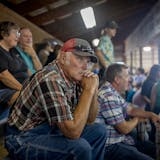In January 1945, five siblings were freed from a Nazi labor camp, not knowing how many Jews were left in the world or where their life journeys would take them.
With both parents dead, they had survived the pain and humiliation of slave labor camps, the constant fear of death, and a gnawing hunger never sated by their watery soup with worms.
Fast forward to now, when the three surviving siblings sat down to a savory meal of chicken and pasta at a Twin Cities country club. They were surrounded by nearly 120 children and grandchildren who had traveled across the country to attend a remarkable reunion honoring the 70th anniversary of their liberation.
"I personally feel it's a miracle," said Reva Kibort, of Golden Valley, the youngest of the five. "We were very lucky," she told the family gathering.
They were also very rare. Usually families were ripped apart in the Holocaust, marched away to war camps, killed outright or worked to death.
"I've not heard of a group of siblings who survived together in labor camps," said Diane Saltzman, director of Survivor Affairs at the United States Holocaust Memorial Museum in Washington, D.C., where she has worked 19 years. The survival of five "is an exceptional experience," she said.
All the siblings eventually made their way to the Twin Cities, where Kibort had been sent to a Jewish foster home in 1947. Staying together was paramount.
"We lost a lot of people in our family, at least 50 cousins," said Mark Mandel, Kibort's brother and a Minnetonka businessman. "So we've always stressed how important family is."


